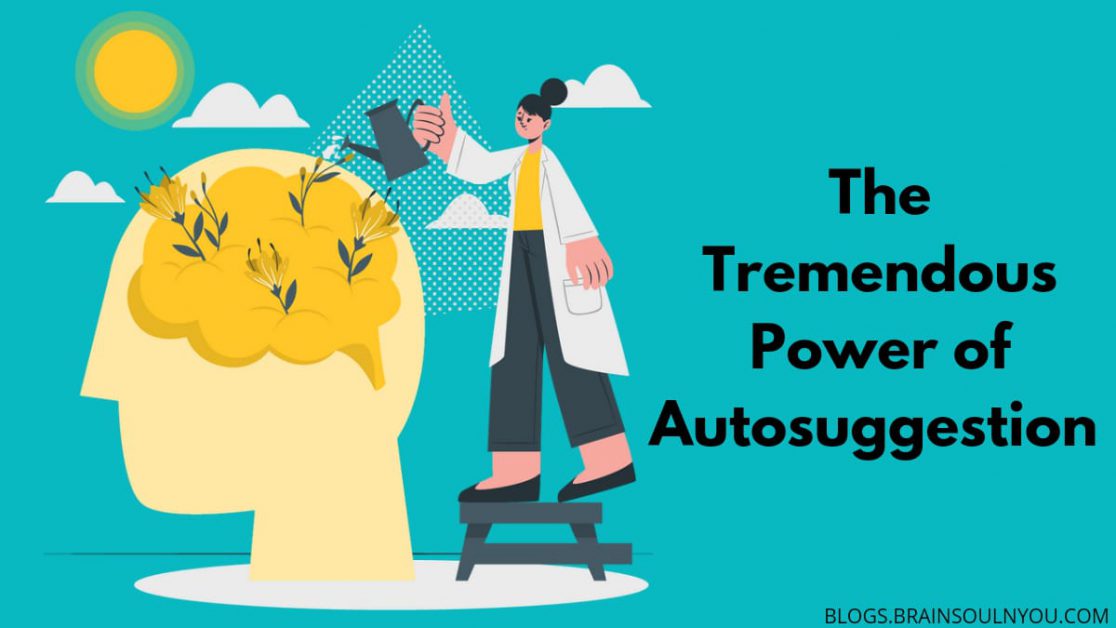Autosuggestion means giving specific suggestions for yourself. Whenever you say something to yourself, your subconscious mind accepts it as the truth and makes it your behavior. If you keep saying something repeatedly then your mind accepts it as true. Like if say that you are not good at public speaking, then your mind accepts it and makes you not good at public speaking.
This is the reason that even if you know how to speak well, as you go to speak in front of the public, you start getting nervous.
The main thing to remember is that once the subconscious mind has accepted an idea, it starts executing it. It is an interesting subtle fact that the law of the subconscious mind works equally for good and bad thoughts. When applied negatively, this law is a cause of failure, despair, and misery.
What is Autosuggestion?
Autosuggestion, also known as self-suggestion or self-hypnosis, is a psychological technique or process of influencing one’s thoughts, beliefs, behaviors, and emotions through self-directed affirmations or repetitive statements. It involves using positive or constructive suggestions to create desired changes in oneself.
The concept of autosuggestion was popularized by Émile Coué, a French psychologist and pharmacist, who believed that the power of suggestion and the repetition of positive affirmations could have a profound impact on one’s well-being and behavior. Coué’s method involved repeating a specific positive affirmation or mantra, such as “Every day, in every way, I am getting better and better,” to bring about positive changes in various areas of life.
The underlying principle behind autosuggestion is that the mind can be influenced and reprogrammed through the repetition of positive thoughts and beliefs. By consistently repeating positive affirmations, individuals aim to replace negative or limiting thoughts with more empowering and constructive ones. The goal is to create new neural pathways in the brain that support desired behaviors, attitudes, and outcomes.
Autosuggestion can be used to address various areas of life, including personal development, self-esteem, confidence, motivation, stress management, and overcoming negative habits or behaviors. It is often used in conjunction with relaxation techniques or visualization exercises to enhance its effectiveness.
Autosuggestion Influences the Subconscious Mind
Whatever you talk to yourself, whether it is positive or negative, you actually give suggestions to your subconscious mind. When you say or think the same thing over and over again, your subconscious mind gets influenced by it.
Yes, autosuggestion is a technique that aims to influence and reprogram the subconscious mind. The subconscious mind refers to the part of our mind that operates below the level of conscious awareness and stores beliefs, habits, memories, and emotions.
Autosuggestion works by repeatedly feeding positive and affirming statements or suggestions to the subconscious mind. Through consistent repetition, these suggestions can bypass the critical faculty of the conscious mind and directly influence the subconscious.

The subconscious mind is highly receptive to suggestions, especially when they are delivered in a relaxed state or through repetitive affirmations. It does not differentiate between real experiences and imagined ones. By using autosuggestion, individuals can reprogram their subconscious mind and replace negative or limiting beliefs with positive and empowering ones.
When positive suggestions are repeatedly reinforced, they can help to create new neural pathways in the brain, modify existing patterns of thinking, and influence behavior. As a result, individuals may experience a shift in their mindset, self-perception, and overall behavior.
It’s important to note that the subconscious mind can also be influenced by external factors, such as experiences, upbringing, and societal conditioning. Autosuggestion is one method individuals can use to intentionally influence their subconscious mind and promote positive changes.
However, it’s worth mentioning that the subconscious mind is complex, and not all suggestions may have an immediate or lasting impact. Factors such as belief systems, emotional attachments, and individual differences can influence the effectiveness of autosuggestion. It may require consistency, patience, and repetition for the desired changes to take root and manifest in one’s thoughts, beliefs, and behaviors.
Autosuggestion is often used in conjunction with other techniques, such as visualization, meditation, and goal-setting, to enhance its effectiveness in influencing the subconscious mind. It is important to approach autosuggestion with a genuine belief in the affirmations being repeated and align them with one’s values and aspirations.
Overall, autosuggestion can be a valuable tool for self-improvement, personal growth, and achieving desired outcomes by harnessing the power of the subconscious mind.
How to Practice Autosuggestion?
To practice autosuggestion effectively, it is important to:
Choose Positive Affirmations: Select positive statements that reflect the desired change or outcome you wish to achieve. These affirmations should be in the present tense, specific, and realistic.
Repeat the Affirmations: Engage in regular repetition of the affirmations, ideally multiple times a day. It can be done silently or aloud, with focus and intention.

Engage in Visualization: Visualize yourself already experiencing the desired outcome while repeating the affirmations. This adds a vivid and sensory component to the process, enhancing its effectiveness.
Believe in the Affirmations: Cultivate a genuine belief and confidence in the affirmations. Embrace them as true statements and allow yourself to fully embody the positive changes they represent.
Consistency and Persistence: It may take time for the desired changes to manifest, so patience and perseverance are key.
It’s important to note that while autosuggestion can be a useful tool for self-improvement and personal growth, it is not a substitute for professional help in addressing serious psychological or emotional issues. In such cases, seeking guidance from a qualified mental health professional is recommended.
Power of Autosuggestion
The power of autosuggestion lies in its ability to influence our thoughts, beliefs, attitudes, and behaviors. By deliberately and repetitively affirming positive statements or suggestions to ourselves, we can create desired changes and outcomes in our lives. Here are some key aspects of the power of autosuggestion:
Shaping Thoughts and Beliefs: Autosuggestion allows us to shape our thoughts and beliefs positively and constructively. By repeatedly affirming positive statements, we can replace negative or limiting thoughts with more empowering and supportive ones. This can lead to a shift in mindset, increased self-confidence, and a more optimistic outlook.
Overcoming Limiting Beliefs: Autosuggestion can help challenge and overcome limiting beliefs that hold us back from reaching our full potential. By consistently affirming new and positive beliefs, we can reprogram our subconscious mind and cultivate a more positive and expansive belief system.
Enhancing Self-Confidence: Autosuggestion can boost self-confidence and self-esteem. By repeatedly affirming our strengths, abilities, and positive qualities, we reinforce a positive self-image, which can empower us to take on challenges, overcome obstacles, and pursue our goals with greater confidence.

Motivating Action: Autosuggestion can serve as a powerful motivator for action. By consistently affirming our goals, aspirations, and desired outcomes, we reinforce our commitment and determination to achieve them. This can provide the drive and focus needed to take consistent steps toward our objectives.
Stress Reduction and Relaxation: Autosuggestion can be used to induce a state of relaxation and reduce stress. By repeatedly affirming calming statements or visualizing peaceful scenes, we can activate the relaxation response in our bodies and minds. This can help reduce anxiety, promote well-being, and enhance overall mental and physical health.
Harnessing the Subconscious Mind: Autosuggestion works by directly influencing the subconscious mind, which is a powerful reservoir of thoughts, beliefs, and memories. By consistently affirming positive suggestions, we can reprogram the subconscious mind and align it with our conscious desires and intentions.
Positive Self-Talk: Autosuggestion involves practicing positive self-talk, which can have a profound impact on our self-perception and emotional well-being. By consciously choosing and repeating positive affirmations, we cultivate a more positive internal dialogue, which can enhance our overall mindset and self-compassion.
The power of autosuggestion is most effective when coupled with consistent action and a genuine belief in the affirmations being repeated. It is not a magical solution or a replacement for addressing deeper psychological issues. However, when used as a complementary practice, autosuggestion can be a valuable tool for personal growth, self-improvement, and achieving desired outcomes.
The Constructive and Destructive Power of Autosuggestion
Autosuggestion, like any psychological technique, can have both constructive and potentially destructive effects depending on how it is used. Here’s an exploration of the constructive and destructive aspects of autosuggestion:
Constructive Power of Autosuggestion:
Positive Self-Image: Autosuggestion can help develop a positive self-image by reinforcing affirming statements and beliefs about oneself. This can improve self-esteem, self-confidence, and overall well-being.
Motivation and Goal Achievement: Autosuggestion can serve as a powerful motivator for pursuing goals and aspirations. By repeatedly affirming desired outcomes and focusing on positive affirmations, individuals can enhance their motivation and drive to achieve success.
Emotional Well-being: Autosuggestion can promote emotional well-being by reinforcing positive thoughts and emotions. It can help individuals manage stress, reduce anxiety, and cultivate a more positive mindset.
Behavior Change: Autosuggestion can be a helpful tool for changing negative habits or behaviors. By consistently affirming positive alternatives, individuals can reinforce desired behaviors and gradually replace unwanted patterns.
Personal Growth and Self-Improvement: Autosuggestion can support personal growth and self-improvement efforts by instilling empowering beliefs and encouraging individuals to embrace their potential. It can foster a growth mindset and encourage continuous self-development.
Destructive Power of Autosuggestion:
Reinforcing Negative Beliefs: If autosuggestion is used to reinforce negative beliefs or self-critical thoughts, it can exacerbate feelings of low self-esteem, self-doubt, and negative self-image. Negative self-talk can perpetuate a cycle of self-sabotage and hinder personal growth.
Ignoring Reality: Autosuggestion should be rooted in realistic expectations and an honest assessment of one’s abilities and limitations. If individuals consistently affirm unrealistic or delusional beliefs without considering reality, it can lead to disappointment and frustration.
Fostering Avoidance: If autosuggestion is used to avoid facing challenges or taking necessary action, it can hinder personal growth. It’s important to strike a balance between positive affirmations and proactive steps toward achieving goals.
Overlooking Personal Responsibility: Autosuggestion should not be used as a means to absolve personal responsibility or blame external factors for one’s circumstances. It’s important to acknowledge personal agency and take ownership of one’s actions.
Ignoring Mental Health Concerns: While autosuggestion can be a useful tool, it is not a substitute for professional help when dealing with serious mental health issues. Individuals should seek appropriate support from mental health professionals for comprehensive evaluation and treatment.
To maximize the constructive power of autosuggestion and mitigate potential risks, it is essential to practice self-awareness, choose affirmations that align with reality and personal values, and maintain a balanced and proactive approach to personal growth.
Combining autosuggestion with other effective strategies, such as seeking support from professionals and engaging in healthy coping mechanisms, can contribute to a more holistic approach to personal development and well-being.
Story Example for Autosuggestion
Once upon a time, there was a young woman named Maya who struggled with low self-esteem and lacked confidence in her abilities. She often doubted herself and felt held back from pursuing her dreams. One day, Maya discovered the power of autosuggestion and decided to give it a try.
Maya began by crafting positive affirmations that countered her negative beliefs. Every morning and evening, she stood in front of the mirror, looked herself in the eyes, and repeated affirmations such as, “I am capable of achieving great things,” “I am deserving of success,” and “I have the skills and talents to overcome any challenge.”

At first, Maya felt a bit skeptical, but she persisted in her practice. Over time, something incredible began to happen. The repeated affirmations started to seep into her subconscious mind, gradually replacing her self-doubt with a newfound sense of confidence and belief in herself.
As Maya continued her daily autosuggestion practice, she noticed positive changes in her life. She became more assertive in expressing her ideas and opinions at work, leading to recognition and opportunities for growth. She pursued her passion for painting, showcasing her artwork in local galleries. Maya even took up public speaking, addressing audiences with poise and conviction.
The power of autosuggestion transformed Maya’s self-image and mindset. She no longer saw herself as inadequate or unworthy but as a capable and deserving individual who could accomplish anything she set her mind to.
Maya’s success inspired her to share the practice of autosuggestion with others. She started hosting workshops and teaching people how to harness the power of their subconscious minds through positive affirmations. Many participants experienced similar transformations, breaking free from self-imposed limitations and achieving remarkable personal growth.
Through her journey, Maya learned that the mind is a powerful tool, and by intentionally programming positive suggestions into the subconscious, individuals can reshape their thoughts, beliefs, and behaviors. She realized that autosuggestion was not just a technique but a pathway to unlocking one’s true potential.
Maya’s story serves as a reminder that with consistent practice and belief in oneself, autosuggestion can have a profound impact on our lives. It allows us to rewrite our inner narrative, replacing self-doubt with self-assurance and embracing our limitless possibilities.
So, you have a brain and you must learn to use it. The mind has two levels: the conscious or rational level, and the subconscious level. You think with your conscious mind and whatever you habitually think gets carried away in your subconscious mind, which creates according to the nature of your thoughts.
Your subconscious mind is the seat of your emotions and is the creative mind. If you think good, good will come; If you think bad, evil will follow you, that’s how your mind works.
Love,
Saurabh Goel
Read also, What is Subconscious Mind? Life-changing Subconscious Mind Programming, How to Change Your Mindset?
Saurabh Goel
He is the Founder and CEO of the Training and Counselling Company ‘Brain Soul & You’. He is an NLP Wellness Coach, Life Coach, Brain analyst, and Trainer for Education, Corporate, and Entrepreneurship. For more than 7 years, he delivered presentations on entrepreneurship, mind programming, and motivation. He did his B.tech in IT and later choose to be a successful psychologist. He is helping people in various ways through his counseling and training sessions.


